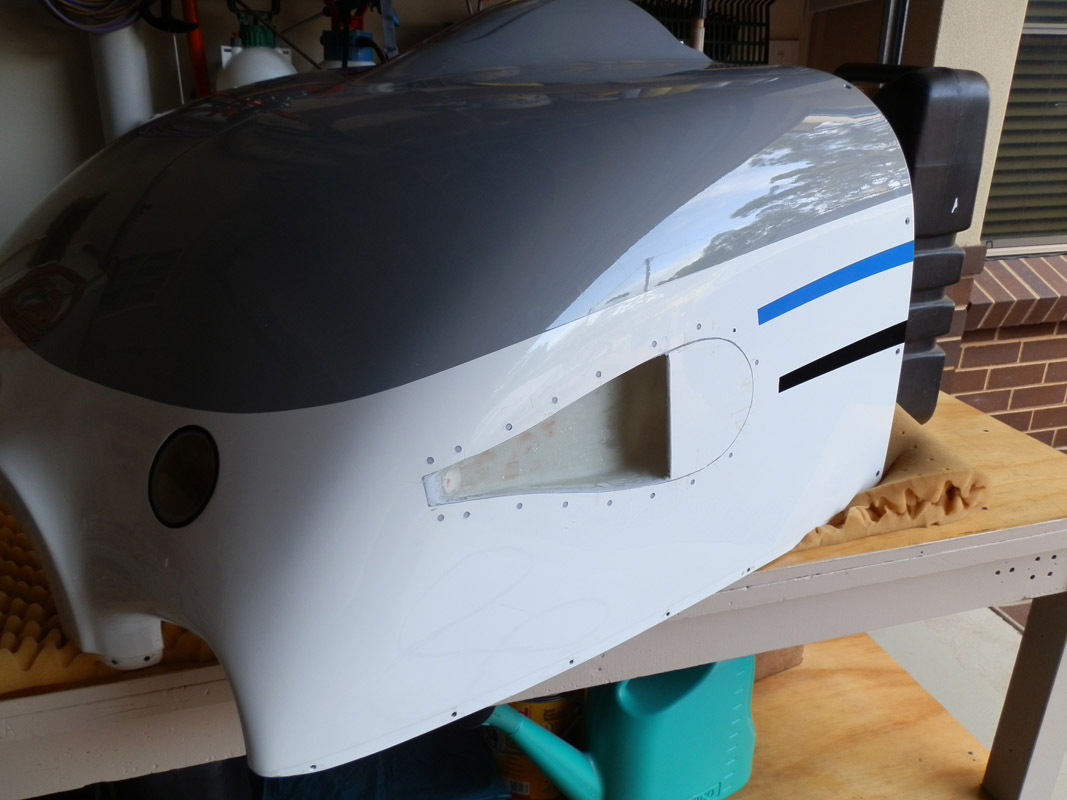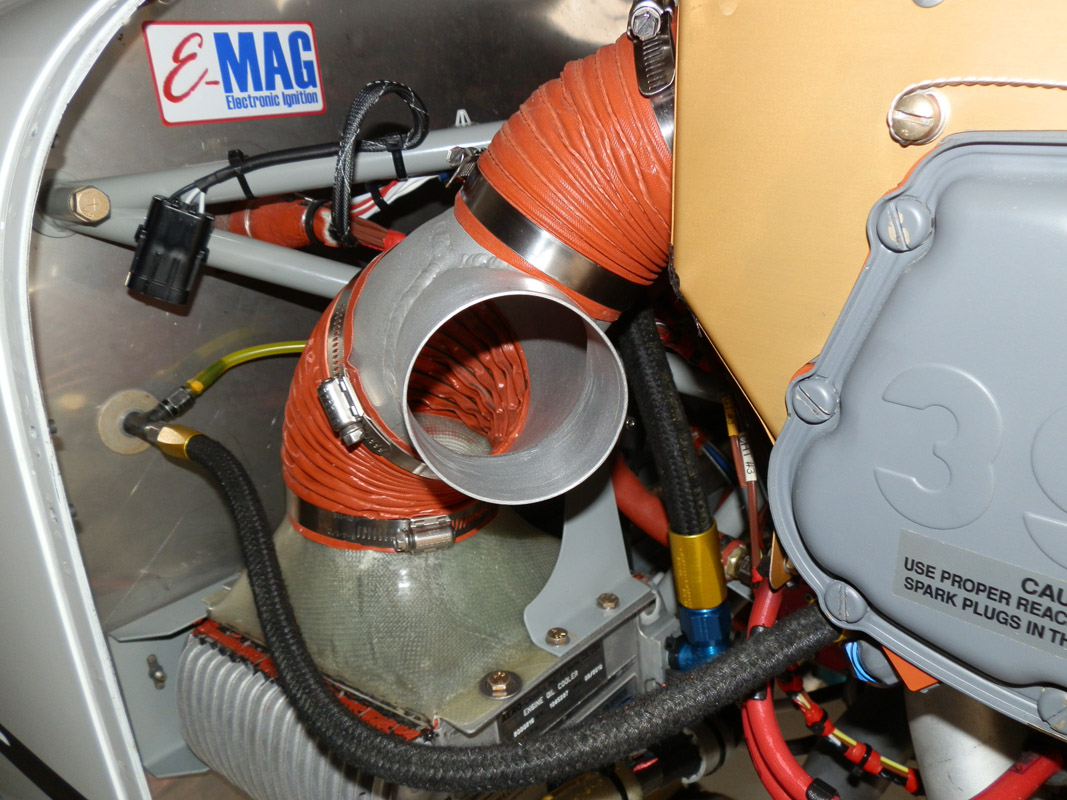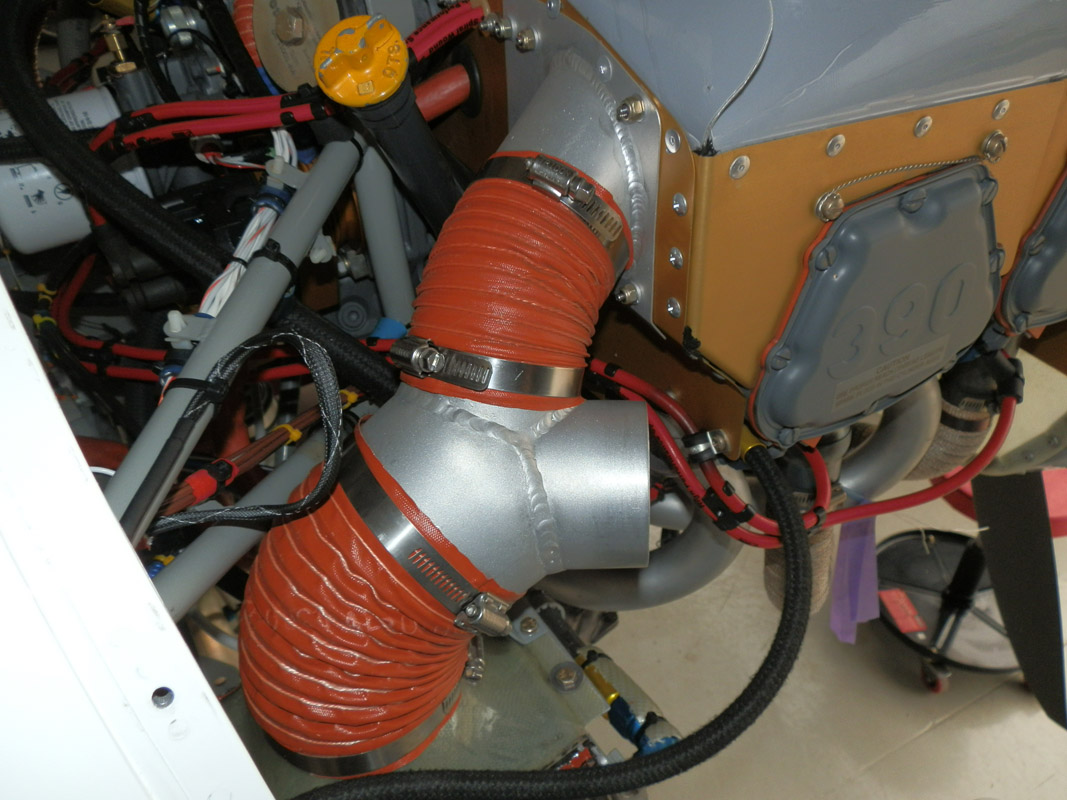Sorting out the oil temperature issues and CHT temperature spread was a bit of a challenge. Extended climbs during Sydney summers had to be well managed to avoid high oil temps. Hand flying my instrument renewal two years ago on a hot and bumpy summer rainy day in the Sydney area with three different approaches and climbs to altitude again had me finishing the flight saying “Never again until I do something about the oil cooling.”
I had used NACA ducts before extensively for cock pit cooling and they did such a great job that I thought that’ll fix it. I carefully scratch built a 3” NACA duct although I note that some nice carbon ones seem to be readily available now. I positioned this carefully to avoid interfering with other engine installation components and allowed for an interference free pathway for 3” scat tube to the oil cooler. I fitted all this and then carefully completely blanked off the gaping 4” hole behind cylinder #3. My scat tube left the rear of the NACA duct, turned upwards and then did a U turn downwards into the existing oil cooler. Not elegant but adequate and I did not want to move an already good oil cooler mounting system.
 With all this in place I launched out of our home airfield thirty miles south of Sydney on a hot day and did an extended climb to 11’000 feet at 95kt indicated. My oil temperature never rose over 208 degrees. I thought you beauty! Problem solved and then nosed over into cruise and the aircraft accelerated. The oil temp slowly began to climb to 210 degrees. I thought hang on! This doesn’t make sense but reduced power and did a U-turn back to the airfield. I retired that night to a friend’s library and found an article by General Dynamics on NACA ducts. You may recall that a test version of the Super Sabre came out with a NACA duct nose instead of the big hole in front. GD found the NACA duct to be completely unsuitable for either turbine or piston engine air intakes. It appears that they work just fine when the air can flow freely through them, as in a slow climb, but when the speed and back pressure build up, the air skips over the surface.
With all this in place I launched out of our home airfield thirty miles south of Sydney on a hot day and did an extended climb to 11’000 feet at 95kt indicated. My oil temperature never rose over 208 degrees. I thought you beauty! Problem solved and then nosed over into cruise and the aircraft accelerated. The oil temp slowly began to climb to 210 degrees. I thought hang on! This doesn’t make sense but reduced power and did a U-turn back to the airfield. I retired that night to a friend’s library and found an article by General Dynamics on NACA ducts. You may recall that a test version of the Super Sabre came out with a NACA duct nose instead of the big hole in front. GD found the NACA duct to be completely unsuitable for either turbine or piston engine air intakes. It appears that they work just fine when the air can flow freely through them, as in a slow climb, but when the speed and back pressure build up, the air skips over the surface.
 Having done all this work with a NACA duct and actually having solved the climb temperature issue the data I had said the NACA duct worked well in climb and the big hole in the rear baffle above cylinder 3 worked well in cruise but took too much air away from cylinder 3. The photos show my solution. I fabricated a floating “Y” piece from 4” and 3” aluminum tube and had a buddy weld it together. I also fabricated a 3” duct to replace the 4” hole in the rear baffle. So we now have two 3” ducts feeding the original 4” duct into the oil cooler. We now have a constant 192 degrees all year round, in climb and in cruise. The CHT in cylinder 3 is still the hottest but now much closer to the other CHTs.
Having done all this work with a NACA duct and actually having solved the climb temperature issue the data I had said the NACA duct worked well in climb and the big hole in the rear baffle above cylinder 3 worked well in cruise but took too much air away from cylinder 3. The photos show my solution. I fabricated a floating “Y” piece from 4” and 3” aluminum tube and had a buddy weld it together. I also fabricated a 3” duct to replace the 4” hole in the rear baffle. So we now have two 3” ducts feeding the original 4” duct into the oil cooler. We now have a constant 192 degrees all year round, in climb and in cruise. The CHT in cylinder 3 is still the hottest but now much closer to the other CHTs.
 The final fix is actually a relatively easy one because it does not involve modifying the existing oil cooler mount and there are some nice ready-made 3” NACA ducts available now from the motor racing industry. You do need to take care where you mount the NACA duct to ensure a free pathway for the scat tube. I have now added a 3” 90-degree silicon bend to the rear of the NACA duct to smooth out the air flow a little and this also reduces the floppy bits when replacing the lower cowl each time. These bends are also readily available in blue or black from the motor racing industry or good auto stores.
The final fix is actually a relatively easy one because it does not involve modifying the existing oil cooler mount and there are some nice ready-made 3” NACA ducts available now from the motor racing industry. You do need to take care where you mount the NACA duct to ensure a free pathway for the scat tube. I have now added a 3” 90-degree silicon bend to the rear of the NACA duct to smooth out the air flow a little and this also reduces the floppy bits when replacing the lower cowl each time. These bends are also readily available in blue or black from the motor racing industry or good auto stores.
When I cut my SCAT tubing I keep a piece of spare 3” aluminum tube and spray mould release on it before spreading red silicone around the inside of the cut scat tube and seating it on the alloy tube. This makes for a neat and longer lasting replaceable duct but you do need to leave it to cure before using it the first time.
It may all sound like a lot of trouble but I flew my instrument renewal again last week with the same three approaches and climbs and thought it was definitely worth it. We don’t have to worry about oil temperatures any more!




